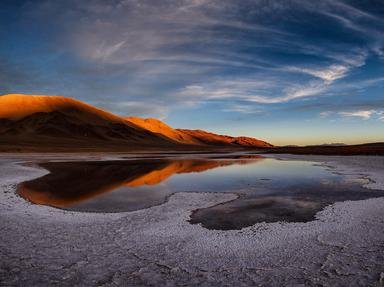Quiz Answer Key and Fun Facts
1. The year 1951 saw the provincialization of two former National Territories. One of them is La Pampa, located in the central southern portion of the country.
All of its territorial limits were defined geometrically, except for one.
Which river marks the southern boundary of La Pampa? People from the US might be reminded of a similar one.
2. The second former National Territory that was granted provincial status in 1951 is Chaco, located at the northeast of the country. At its creation, though, it went by a different name, honoring a notable politician who was President of the country at that time.
After which of these personalities was the province originally named?
3. The small province of Misiones was created in 1953, and it is located at the northeastern tip of the country. Its main touristic attraction, shared with Brazil, is one of the most massive waterfalls in the world.
Drawing an estimated 1.5 million tourists yearly, which one of these can be visited at Misiones?
4. Our last stop in the Northeast of Argentina is this province that shares its name with the former denomination of the main island of Taiwan. What is it called?
5. It's time to go all the way south, and enter the Patagonia region. The northernmost province of the area has a palindromic name, taken from a nearby river. What is it called?
6. Heading southwards, we enter Rio Negro province. On the far west of the province you can find a major touristic city on the shores of the Nahuel Huapi lake.
Known for its beautiful mountainous landscapes and delicious chocolate, what city are we referring to?
7. Further to the south is Chubut, the third largest province of Argentina. This province is the only one in which a European language (other than Spanish) is spoken in some regions, since Chubut is home to a small colony of people from a distant place.
People from which country, known for daffodils and leeks, have settled in Chubut?
8. The last continental province of Argentina is Santa Cruz, being the second largest in extension, behind Buenos Aires. At its extreme west, you can find Argentina's largest national park, which is home to what chilly type of natural feature?
9. At the remote southern tip we find Tierra del Fuego, which was granted provincial status in 1990. Its capital city claims the title of being the southernmost capital city in the world.
What is it called?
10. During the first half of the 20th century, Argentina had an extra political unit. Located within the Atacama Plateau, in the northwest of the territory, it was named after the mountain chain that forms the boundary between Argentina and Chile.
What was the name of this "province"?
Source: Author
Gispepfu
This quiz was reviewed by FunTrivia editor
agony before going online.
Any errors found in FunTrivia content are routinely corrected through our feedback system.
